Seasonal Dynamics and Trade-Offs/Synergies of Cultural Ecosystem Services in Urban Parks: A Case Study of Chengdu, China
Abstract
1. Introduction
2. Methodology
2.1. Study Area
2.2. Research Design
2.3. Data Source and Preparation
2.4. CES Evaluation Method
2.4.1. Construction of a Structured Text for Urban Park CESs
2.4.2. CES Evaluation Index
2.5. Seasonal CES Dynamics
2.5.1. CES Distribution Characteristics
- (1)
- Global Moran’s I
- (2)
- Lorenz curve and Gini coefficient
2.5.2. CES Intensity Characteristics
- (1)
- CES intensity statistics in different seasons
- (2)
- Seasonal concentration degree index across the four seasons
2.6. Trade-Offs/Synergies of CESs
2.6.1. Pearson Analysis
2.6.2. Ecosystem Service Bundle Analysis
3. Results
3.1. CESs and Their Seasonal Variations
3.1.1. Seasonal CES Intensity Dynamic
3.1.2. Spatial Variation Characteristics of CESs
3.2. CES Trade-Offs/Synergies and Their Seasonal Variation
3.2.1. CES Trade-Offs/Synergies for the Service Pair
3.2.2. CES Trade-Offs/Synergies for Multiple Services
4. Discussion
4.1. CES Changes Among Different Seasons
4.2. Seasonal Variation in the CES Trade-Off
4.2.1. CES Pair Relationship
4.2.2. Relationships Between Multiple CESs
4.3. Management Implications for Urban Parks
4.3.1. Focus on Maintaining Recreation Activities and Improving Education Service
4.3.2. Promotion of CES Synergy and Alleviation of the CES Trade-Off
4.3.3. Classified Management of the Urban Parks with Different CES Bundles
4.4. Limitations and Future Studies
5. Conclusions
Author Contributions
Funding
Data Availability Statement
Conflicts of Interest
References
- Jackson, L. The relationship of urban design to human health and condition. Landsc. Urban Plan. 2003, 64, 191–200. [Google Scholar] [CrossRef]
- Millennium Ecosystem Assessment. Ecosystems and Human Well-Being; Island Press: Washington, DC, USA, 2005. [Google Scholar]
- Wang, Z.; Miao, Y.; Xu, M.; Zhu, Z.; Qureshi, S.; Chang, Q. Revealing the differences of urban parks’ services to human wellbeing based upon social media data. Urban For. Urban Green. 2021, 63, 127233. [Google Scholar] [CrossRef]
- Shang, Z.; Cheng, K.; Jian, Y.; Wang, Z. Comparison and Applicability Study of Analysis Methods for Social Media Text Data: Taking Perception of Urban Parks in Beijing as an Example. Landsc. Archit. Front. 2023, 8–29. [Google Scholar] [CrossRef]
- Riechers, M.; Barkmann, J.; Tscharntke, T. Diverging perceptions by social groups on cultural ecosystem services provided by urban green. Landsc. Urban Plan. 2018, 175, 161–168. [Google Scholar] [CrossRef]
- Cao, H.; Wang, M.; Su, S.; Kang, M. Explicit quantification of coastal cultural ecosystem services: A novel approach based on the content and sentimental analysis of social media. Ecol. Indic. 2022, 137, 108756. [Google Scholar] [CrossRef]
- Wolch, J.; Byrne, J.; Newell, J. Urban green space, public health, and environmental justice: The challenge of making cities ‘just green enough’. Landsc. Urban Plan. 2014, 125, 234–244. [Google Scholar] [CrossRef]
- Gai, S.; Fu, J.; Rong, X.; Dai, L. Users’ views on cultural ecosystem services of urban parks: An importance-performance analysis of a case in Beijing, China. Anthropocene 2022, 37, 100323. [Google Scholar] [CrossRef]
- Campbell, L.; Svendsen, E.; Sonti, N.; Johnson, M.L. A social assessment of urban parkland: Analyzing park use and meaning to inform management and resilience planning. Environ. Sci. Policy 2016, 62, 34–44. [Google Scholar] [CrossRef]
- Kičić, M.; Scheuer, S.; Korpilo, S.; Vuletić, D.; Seletković, A.; Haase, D.; Ostoić, S.K. Relationships between urban green space types, cultural ecosystem services and disservices-a Public Participation Geographic Information System study in Zagreb, Croatia. Sci. Total Environ. 2025, 981, 179549. [Google Scholar] [CrossRef]
- Huai, S.; Liu, S.; Zheng, T.; Van de Voorde, T. Are social media data and survey data consistent in measuring park visitation, park satisfaction, and their influencing factors? A case study in Shanghai. Urban For. Urban Green. 2023, 81, 127869. [Google Scholar] [CrossRef]
- Kong, I.; Sarmiento, F.; Mu, L. Crowdsourced text analysis to characterize the US National Parks based on cultural ecosystem services. Landsc. Urban Plan. 2023, 233, 104692. [Google Scholar] [CrossRef]
- Rodríguez, J.; Beard, T., Jr.; Bennett, E.; Cumming, G.S.; Cork, S.J.; Agard, J.; Dobson, A.P.; Peterson, G.D. Trade-offs across space, time, and ecosystem services. Ecol. Soc. 2006, 11. Available online: http://www.ecologyandsociety.org/vol11/iss1/art28/ (accessed on 20 October 2025). [CrossRef]
- Ament, J.; Moore, C.; Herbst, M.; Cumming, G. Cultural ecosystem services in protected areas: Understanding bundles, trade-offs, and synergies. Conserv. Lett. 2017, 10, 440–450. [Google Scholar] [CrossRef]
- Zhao, Y.; You, W.; Lin, X.; He, D.; Wen, H. Perception of cultural ecosystem services in Wuyishan City from the perspective of tourists and residents. Acta Ecol. Sin. 2022, 42, 4011–4022. [Google Scholar] [CrossRef]
- Turner, K.; Odgaard, M.; Bøcher, P.; Dalgaard, T.; Svenning, J.-C. Bundling ecosystem services in Denmark: Trade-offs and synergies in a cultural landscape. Landsc. Urban Plan. 2014, 125, 89–104. [Google Scholar] [CrossRef]
- Cheng, X.; Van Damme, S.; Li, L.; Uyttenhove, P. Cultural ecosystem services in an urban park: Understanding bundles, trade-offs, and synergies. Landsc. Ecol. 2022, 37, 1693–1705. [Google Scholar] [CrossRef]
- Guo, R.; Lin, L.; Xu, J.; Dai, W.-H.; Song, Y.-B.; Dong, M. Spatio-temporal characteristics of cultural ecosystem services and their relations to landscape factors in Hangzhou Xixi National Wetland Park, China. Ecol. Indic. 2023, 154, 110910. [Google Scholar] [CrossRef]
- Huang, S.; Xiao, X.; Tian, T.; Che, Y. Seasonal influences on preferences for urban blue-green spaces: Integrating land surface temperature into the assessment of cultural ecosystem service value. Sustain. Cities Soc. 2024, 102, 105237. [Google Scholar] [CrossRef]
- Chengdu Institute of Planning and Design. Chengdu Beautiful and Livable Park City Plan (2018–2035); Chengdu Institute of Planning and Design: Chengdu, China, 2019; Available online: https://www.cdipd.org.cn/index.php?m=content&c=index&a=show&catid=85&id=88 (accessed on 15 November 2019). (In Chinese)
- State Council of China. Official Reply of the State Council on Approving Chengdu to Build It into a Park City Demonstration Area that Practices the New Development Philosophy; State Council of China: Beijing, China, 2022. Available online: https://www.gov.cn/zhengce/zhengceku/2022-02/10/content_5672903.htm (accessed on 10 February 2022). (In Chinese)
- China (International) Leisure Development Forum. China’s Top Ten Leisure Cities; China (International) Leisure Development Forum: Nanjing, China, 2010. [Google Scholar]
- Chengdu Municipal Statistics Bureau. Chengdu Statistical Yearbook in 2023; Chengdu Municipal Statistics Bureau: Chengdu, China, 2023. Available online: https://cdstats.chengdu.gov.cn/cdstjj/c155010/list.shtml (accessed on 24 October 2024). (In Chinese)
- Jiang, Q.; Wang, G.; Li, J. Public Perception of Cultural Ecosystem Services in Urban Parks: A Case Study of Urban Parks of Jinan City Proper. Landsc. Archit. 2022, 29, 127–133. [Google Scholar]
- Costanza, R.; De Groot, R.; Braat, L.; Kubiszewski, I.; Fioramonti, L.; Sutton, P.; Farber, S.; Grasso, M. Twenty years of ecosystem services: How far have we come and how far do we still need to go? Ecosyst. Serv. 2017, 28, 1–16. [Google Scholar] [CrossRef]
- Li, J.; Gao, J.; Zhang, Z.; Fu, J.; Shao, G.; Zhao, Z.; Yang, P. Insights into citizens’ experiences of cultural ecosystem services in urban green spaces based on social media analytics. Landsc. Urban Plan. 2024, 244, 104999. [Google Scholar] [CrossRef]
- De Souza Queiroz, L.; Rossi, S.; Calvet-Mir, L.; Ruiz-Mallén, I.; García-Betorz, S.; Salvà-Prat, J.; de Andrade Meireles, A.J. Neglected ecosystem services: Highlighting the socio-cultural perception of mangroves in decision-making processes. Ecosyst. Serv. 2017, 26, 137–145. [Google Scholar] [CrossRef]
- Plieninger, T.; Dijks, S.; Oteros-Rozas, E.; Bieling, C. Assessing, mapping, and quantifying cultural ecosystem services at community level. Land Use Policy 2013, 33, 118–129. [Google Scholar] [CrossRef]
- Hale, R.; Cook, E.; Beltrán, B. Cultural ecosystem services provided by rivers across diverse social-ecological landscapes: A social media analysis. Ecol. Indic. 2019, 107, 105580. [Google Scholar] [CrossRef]
- Han, J.; Han, F.; Dunets, A.; Batbayar, B. Mapping transboundary ecological networks for conservation in the Altai Mountains. Ecol. Indic. 2024, 169, 112869. [Google Scholar] [CrossRef]
- Lucas, K.; Van Wee, B.; Maat, K. A method to evaluate equitable accessibility: Combining ethical theories and accessibility-based approaches. Transportation 2016, 43, 473–490. [Google Scholar] [CrossRef]
- Fernandez-Morales, A. Decomposing seasonal concentration. Ann. Tour. Res. 2003, 30, 942–956. [Google Scholar] [CrossRef]
- Buchel, S.; Frantzeskaki, N. Citizens’ voice: A case study about perceived ecosystem services by urban park users in Rotterdam, the Netherlands. Ecosyst. Serv. 2015, 12, 169–177. [Google Scholar] [CrossRef]
- Koh, Y.; Loc, H.; Park, E. Towards a “City in nature”: Evaluating the cultural ecosystem services approach using online public participation GIS to support urban green space management. Sustainability 2022, 14, 1499. [Google Scholar] [CrossRef]
- Bi, X.; Gan, X.; Jiang, Z.; Li, Z.; Li, J. How do landscape patterns in urban parks affect multiple cultural ecosystem services perceived by residents? Sci. Total Environ. 2024, 946, 174255. [Google Scholar] [CrossRef] [PubMed]
- Guan, C.; Song, J.; Keith, M.; Zhang, B.; Akiyama, Y.; Da, L.; Shibasaki, R.; Sato, T. Seasonal variations of park visitor volume and park service area in Tokyo: A mixed-method approach combining big data and field observations. Urban For. Urban Green. 2017, 58, 126973. [Google Scholar] [CrossRef]
- Yue, B.; Qian, Z. Formation Mechanism of Trade-offs and Synergies Between Ecosystem Services and Application in Landscape Planning. Landsc. Archit. 2022, 29, 20–25. [Google Scholar]
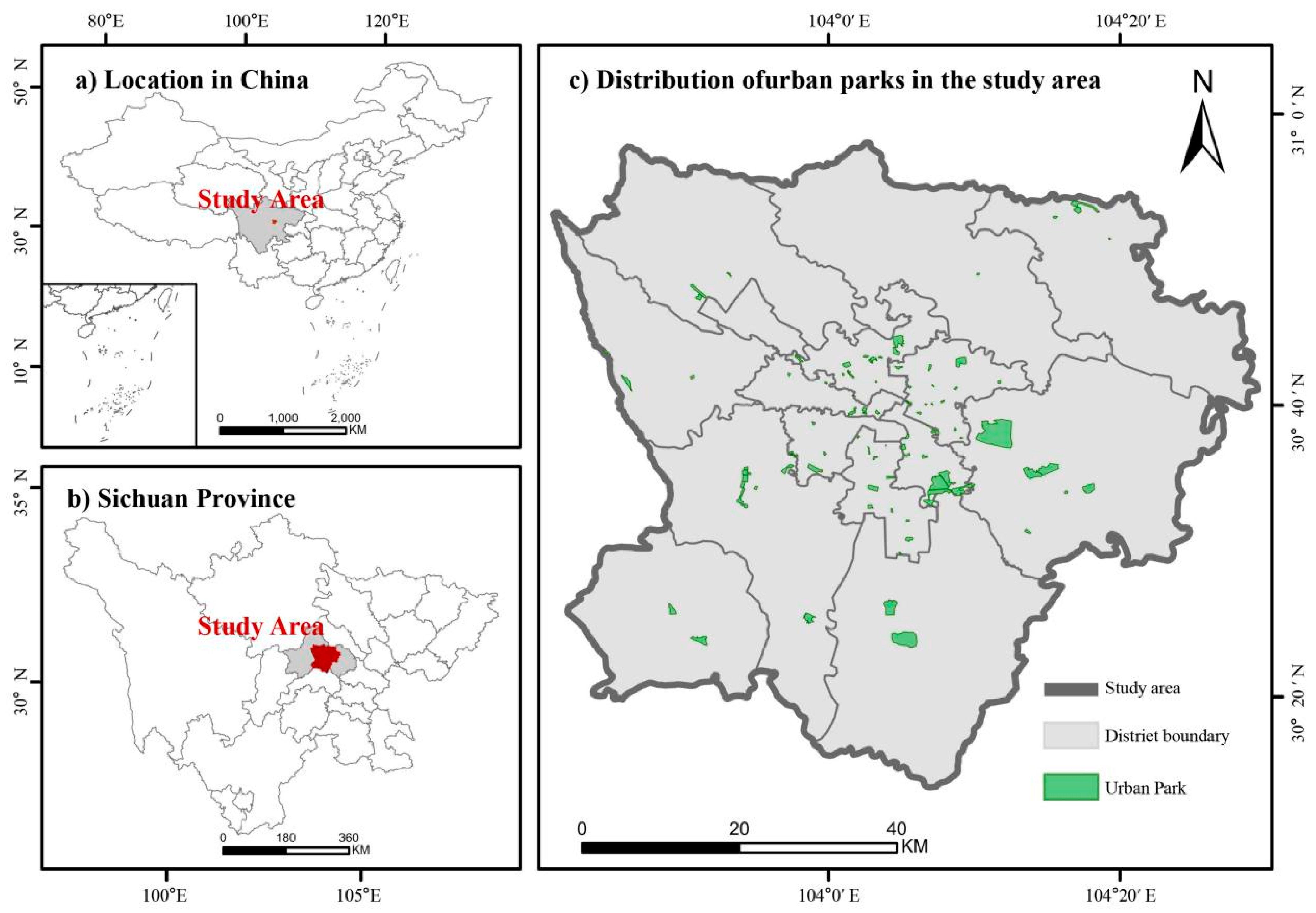
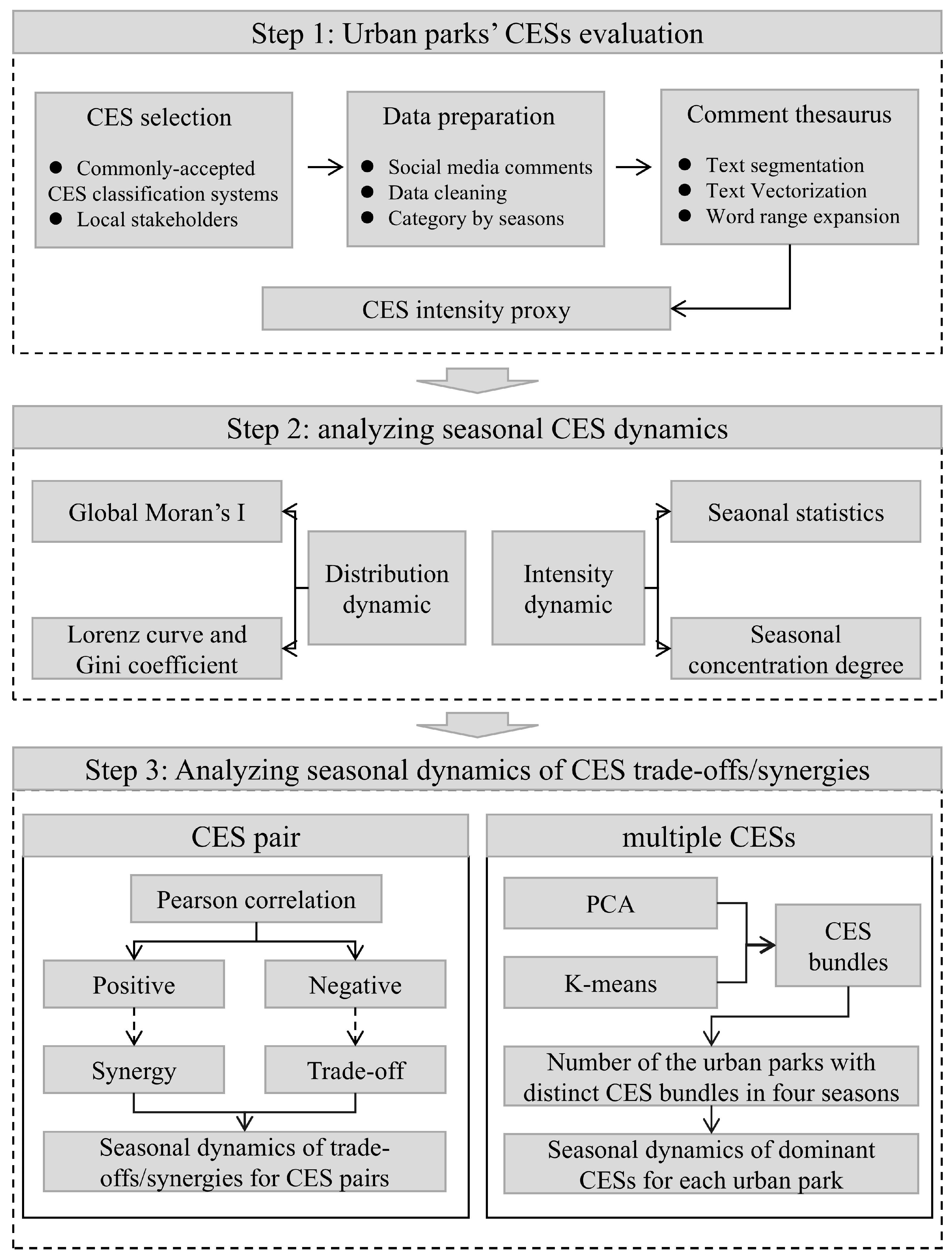
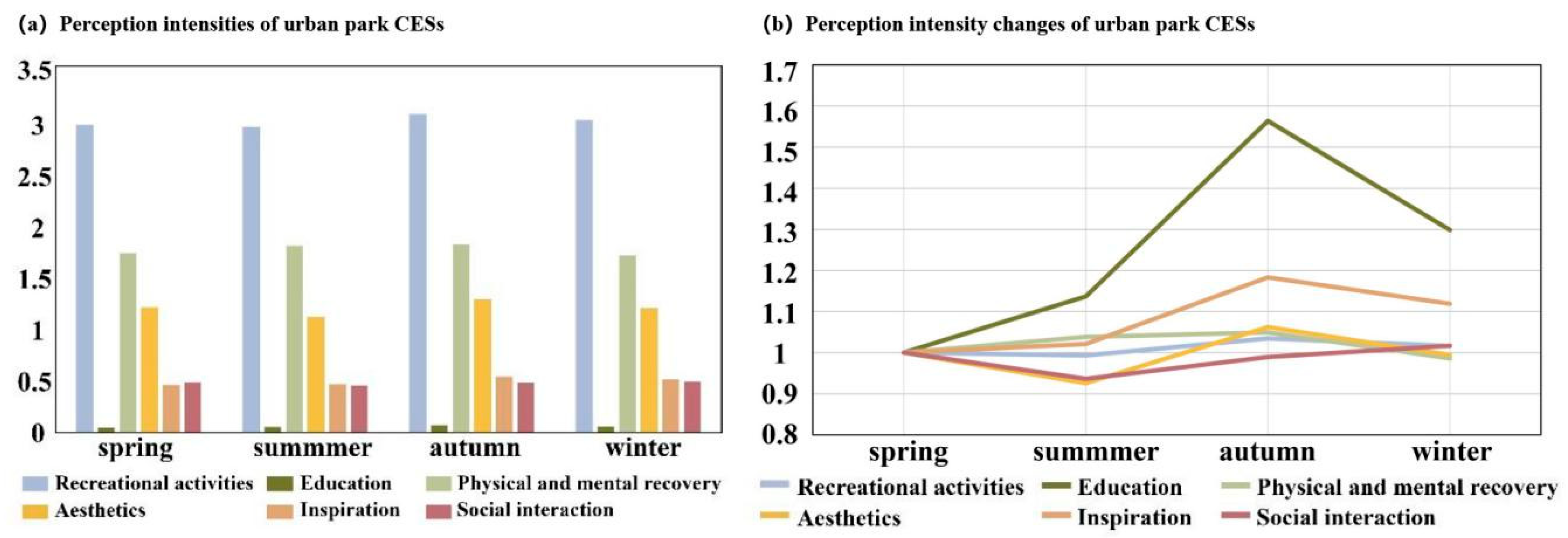
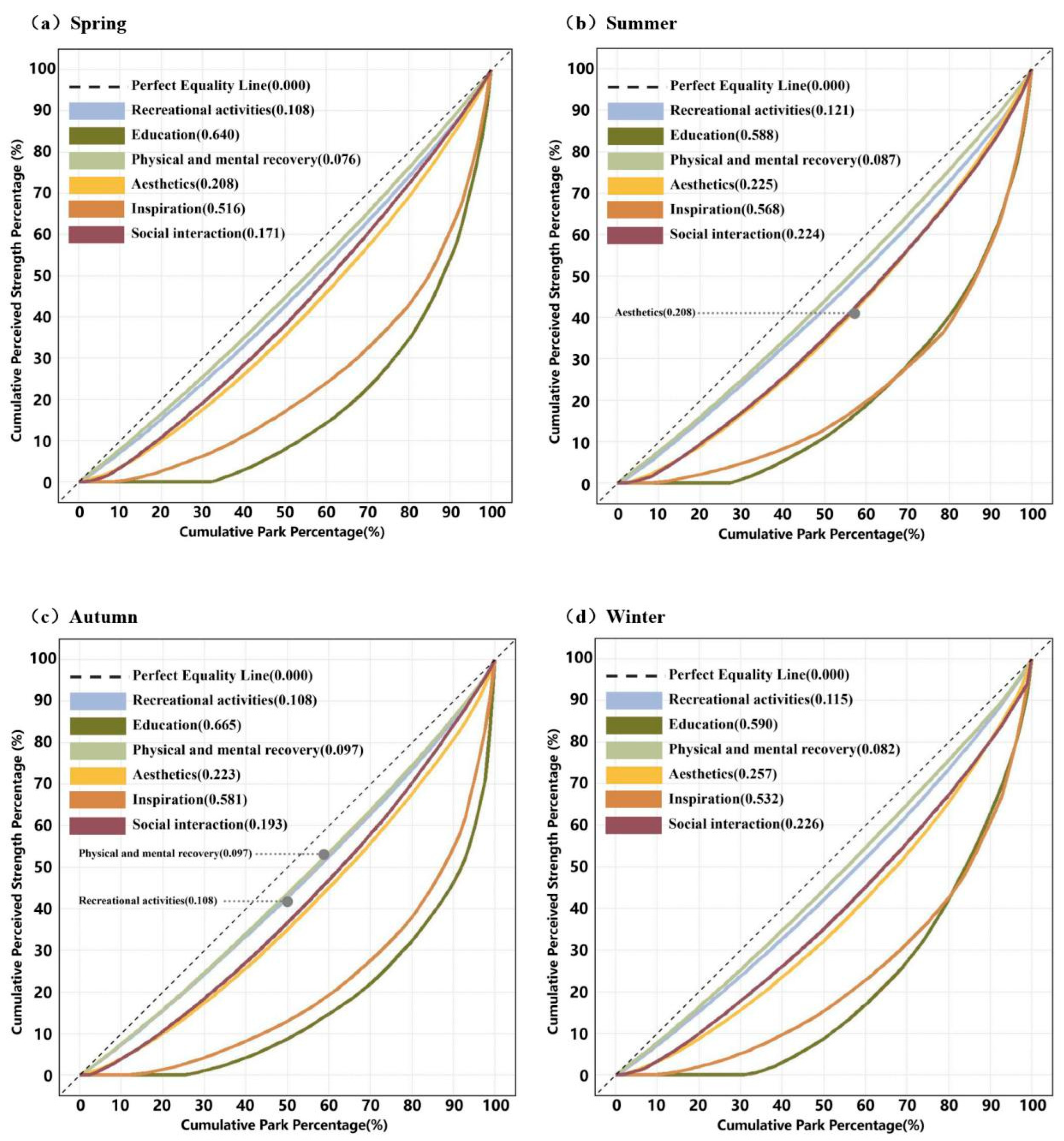

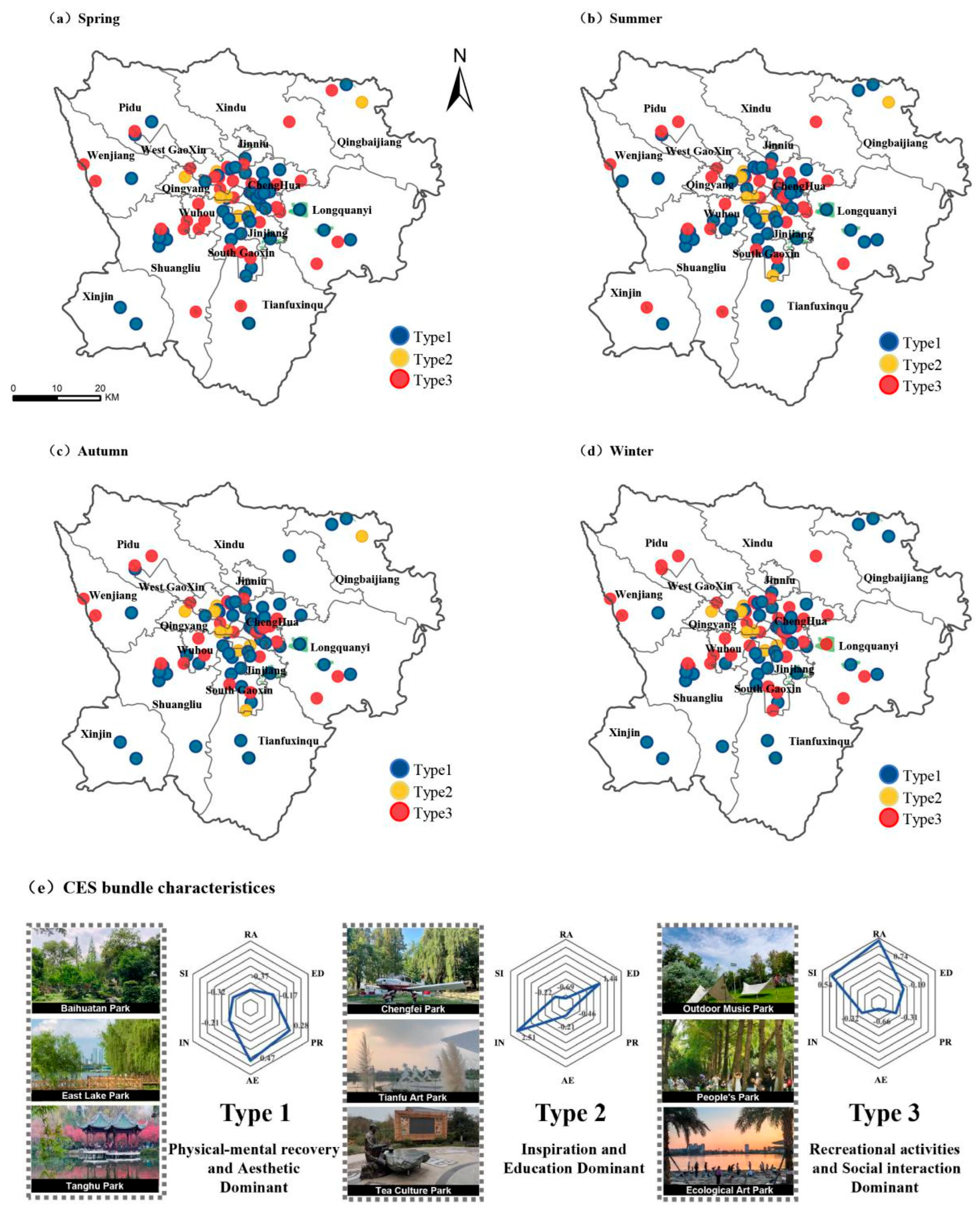
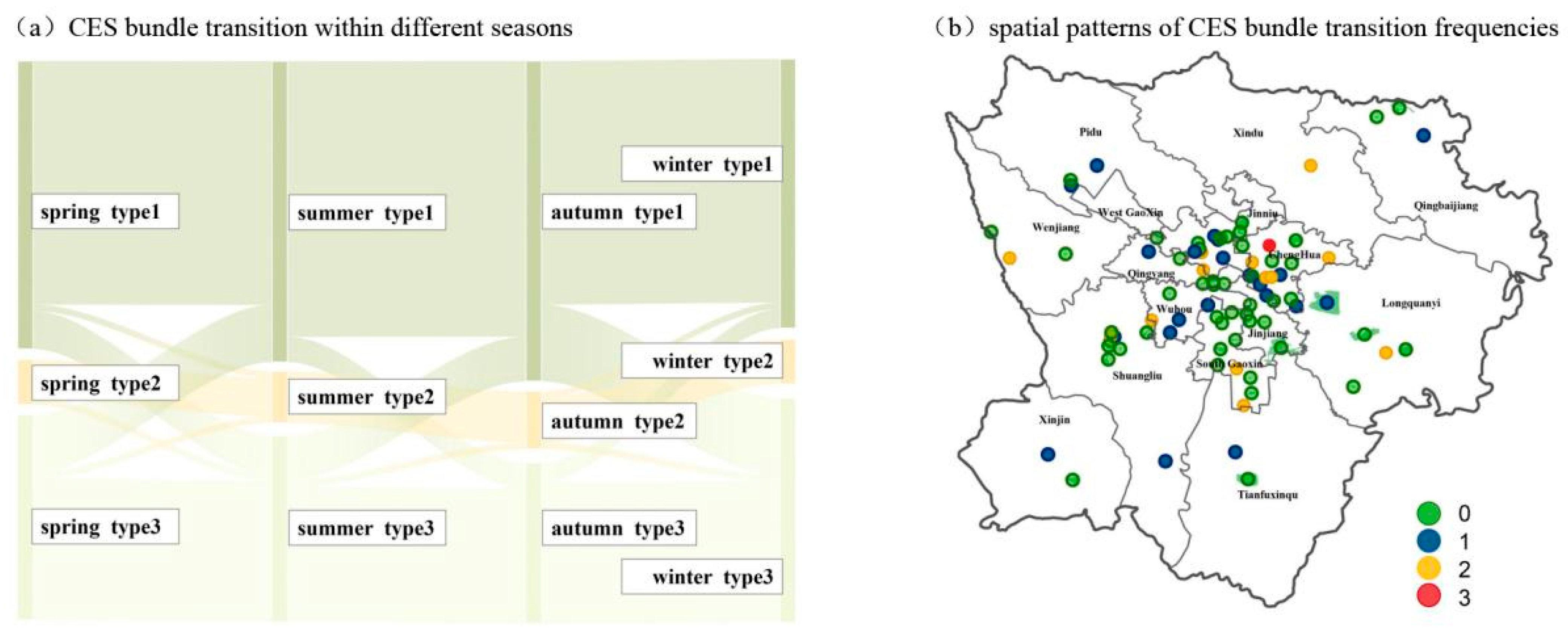
| CES Type | Explanation | Representative Vocabulary |
|---|---|---|
| Education | Urban parks provide opportunities for the public to obtain knowledge and education. | Science popularisation; Research; Crafts; Teaching; Commentary |
| Social interaction | Urban parks provide places for residents to socialise and meet their social needs. | Friends; Family; Dinner; Chatting; Singing; Picnic |
| Aesthetics | Aesthetic information obtained from viewing the interior scenery of the park. | Taking pictures; Beautiful; Scenery; Colourful; Scenery |
| Physical and mental recovery | Urban parks provide a series of natural and man-made landscapes to meet people’s needs for rest and mental stress reduction. | Comfortable; Calm; Stress-relieving; Refreshed |
| Recreational activities | Urban parks provide people with the services and resources for leisure, entertainment, and recreation. | Boating, Playground; Leisure; Garden party; Chess game |
| Inspiration | Artistic inspiration is inspired by the natural or cultural landscape of the park. | Art exhibitions; Places of interest; Romanticism; Museums; A sense of history |
| Recreational Activities | Education | Physical and Mental Recovery | Aesthetics | Inspiration | Social Interaction |
|---|---|---|---|---|---|
| 0.39 | 4.20 | 0.64 | 1.21 | 1.72 | 0.76 |
| Recreational Activities | Education | Physical and Mental Recovery | Aesthetics | Inspiration | Social Interaction | |
|---|---|---|---|---|---|---|
| Spring | 0.036520 | −0.005314 | 0.062788 | 0.027328 | 0.074008 * | 0.050884 |
| Summer | 0.008186 | −0.033007 | −0.019778 | 0.034717 | 0.058878 | 0.017375 |
| Fall | −0.037574 | −0.031924 | −0.007281 | −0.004967 | 0.067429 * | 0.022975 |
| Winter | 0.000493 | 0.024646 | −0.00282 | −0.001377 | 0.13378 * | −0.002811 |
Disclaimer/Publisher’s Note: The statements, opinions and data contained in all publications are solely those of the individual author(s) and contributor(s) and not of MDPI and/or the editor(s). MDPI and/or the editor(s) disclaim responsibility for any injury to people or property resulting from any ideas, methods, instructions or products referred to in the content. |
© 2025 by the authors. Licensee MDPI, Basel, Switzerland. This article is an open access article distributed under the terms and conditions of the Creative Commons Attribution (CC BY) license (https://creativecommons.org/licenses/by/4.0/).
Share and Cite
Lyu, B.; Gao, Z.; Wang, Y.; Liu, J.; Zhang, L.; Song, J.; Pan, Y.; Cheng, M.; Liu, S.; Chen, Q.; et al. Seasonal Dynamics and Trade-Offs/Synergies of Cultural Ecosystem Services in Urban Parks: A Case Study of Chengdu, China. Land 2025, 14, 2126. https://doi.org/10.3390/land14112126
Lyu B, Gao Z, Wang Y, Liu J, Zhang L, Song J, Pan Y, Cheng M, Liu S, Chen Q, et al. Seasonal Dynamics and Trade-Offs/Synergies of Cultural Ecosystem Services in Urban Parks: A Case Study of Chengdu, China. Land. 2025; 14(11):2126. https://doi.org/10.3390/land14112126
Chicago/Turabian StyleLyu, Bingyang, Zihan Gao, Yike Wang, Jing Liu, Liyin Zhang, Jialu Song, Yinuo Pan, Min Cheng, Shiliang Liu, Qibing Chen, and et al. 2025. "Seasonal Dynamics and Trade-Offs/Synergies of Cultural Ecosystem Services in Urban Parks: A Case Study of Chengdu, China" Land 14, no. 11: 2126. https://doi.org/10.3390/land14112126
APA StyleLyu, B., Gao, Z., Wang, Y., Liu, J., Zhang, L., Song, J., Pan, Y., Cheng, M., Liu, S., Chen, Q., Lu, L., & Li, K. (2025). Seasonal Dynamics and Trade-Offs/Synergies of Cultural Ecosystem Services in Urban Parks: A Case Study of Chengdu, China. Land, 14(11), 2126. https://doi.org/10.3390/land14112126








